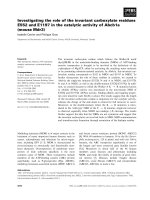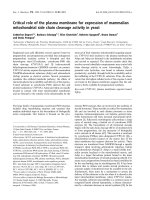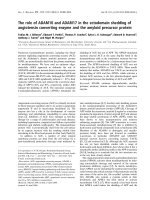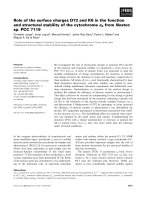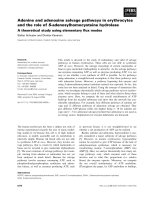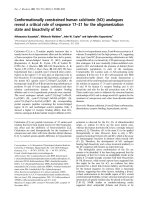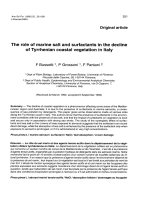Critical role of p53 and K-ras in the diagnosis of early colorectal cancer: A one year, single center analysis
Bạn đang xem bản rút gọn của tài liệu. Xem và tải ngay bản đầy đủ của tài liệu tại đây (1.15 MB, 9 trang )
Int. J. Med. Sci. 2017, Vol. 14
Ivyspring
International Publisher
1154
International Journal of Medical Sciences
2017; 14(11): 1154-1162. doi: 10.7150/ijms.20538
Research Paper
Critical Role of p53 and K-ras in the Diagnosis of Early
Colorectal Cancer: a One-year, Single-center Analysis
Hui-Ying Lu, Ri-Tian Lin, Guang-Xi Zhou, Tian-Ming Yu, Zhan-Ju Liu
Department of Gastroenterology, The Shanghai Tenth People’s Hospital, Tongji University, Shanghai 200072, China
Corresponding author: Zhan-Ju Liu, MD, PhD, Department of Gastroenterology, The Shanghai Tenth People’s Hospital, Tongji University, Shanghai 200072,
China. Email:
© Ivyspring International Publisher. This is an open access article distributed under the terms of the Creative Commons Attribution (CC BY-NC) license
( See for full terms and conditions.
Received: 2017.04.12; Accepted: 2017.08.07; Published: 2017.09.13
Abstract
Background: Colorectal cancer (CRC) is strongly associated with colorectal polyps, which has
become the third most common cancer in China. In the present study, we revealed the susceptible
population and risk factors of colorectal polyps, and analyzed the expression of Ki−67, p53 and
K−ras in the intestinal mucosa of patients with colorectal polyps in order to explore their
significance in the detection and prognosis of CRC at an early stage.
Materials and Methods: Total 801 cases of colorectal polyps were collected during endoscopic
resection including endoscopic mucosal resection (EMR) and endoscopic submucosal dissection
(ESD). Expression of Ki−67, p53 and K−ras in the intestinal mucosa was detected by
immunohistochemistry and quantitative real−time polymerase chain reaction (qRT−PCR),
respectively. Histological analysis was performed by Hematoxylin and eosin (HE) staining.
Categorical variables were compared by one−way ANOVA, Pearson test, Spearman test,
Kruskal−Wallis test and analysis of regression.
Results: Of all patients with colorectal polyps, 90.76% of patients (n = 727) were ≥ 50 years old.
530 cases (66.17%) were males compared with 271 females (33.83%) in all 801 cases. More
importantly, 1.03% patients (n = 7) underwent polypectomy and histological examination was
confirmed to be the early stage of CRC. The expression of p53 was found to be significantly
decreased, while K−ras was increased in tumor tissues of CRC compared with that in hyperplastic
polyps and healthy controls.
Conclusions: 1.03% patients (n = 7) underwent polypectomy was confirmed to be the early stage
of CRC. Histological analysis for expression of p53 and K−ras can guarantee to screen the early
stage of CRC.
Key words: colorectal cancer, colorectal polyps, cancer prediction, histological analysis, clinical characteristics.
Introduction
It is becoming increasingly difficult to ignore the
increased prevalence of colorectal cancer (CRC)
during past decades, which has become the third
leading cause of cancer death worldwide [1, 2].
Although considerable progress has been made in
investigating the pathogenesis and clinical therapy of
CRC, tumor excision is the main treatment of choice
with a poor 5−year survival rate below 65% [2, 3].
Therefore, detection of CRC in early stage and
exploring the progression of CRC are urgent [4].
Colorectal adenoma (CRA) is broadly identified as the
pre−neoplastic lesion according to the adenoma–
colorectal cancer sequence; it takes decades to
transform adenoma into carcinoma after a stepwise
accumulation of genetic mutations [5-7]. Thus, CRA is
widely accepted as the most potential precursor lesion
of CRC [5-7]. As for the clinical view, it would be of
paramount significance to be able to detect any
precursor lesion of neoplasia as early as possible [8, 9].
With the technical progression of colonoscopy and the
Int. J. Med. Sci. 2017, Vol. 14
pervasive
application
of
clinicopathological
examination, evidence has demonstrated that the
adenoma–colorectal cancer sequence may be
generally defined as benign lesions with dysplastic
epithelia that have the malignant potential [10, 11].
Through years of research and practice, plenty of
screening techniques for colorectal polyps allow us to
choose, including digital rectal examination, barium
enema, colonoscopy and computed tomography
colonography [12-17]. Because colonoscopy allows the
detection and removal of polyps in only one−step
approach,
studies
have
revealed
that
population−based screening and removal of high−risk
adenomas have become the cornerstone of CRC
prevention [14, 15, 17]. Since screening colonoscopy is
an invasive procedure with potentially adverse
events, high−tech equipments are needed such as
computed tomography colonography, which has
excellent sensitivity compared to colonoscopy and
high levels of patient acceptability [12]. Even so,
colonoscopy is still one of the routine screening tools
for colorectal polyps screening and the key approach
which is widely utilized in the clinic [18, 19].
The protein antigen Ki−67, also named MKI−67,
is a nucleoprotein coded by MKI−67 gene and
generally used as an indicator of proliferation in
immunohistochemistry due to its restricted
expression between the S and the M phases of the cell
cycle in differentiating cells [20]. It is widely accepted
that Ki−67 is a crucial nucleoprotein for the
differentiated degree, infiltration, transfer and
prognosis of cancer because of its relationship with
rRNA transcription [21]. According to previous
studies, Ki−67 expresses both in normal colonic tissue
and in polyps [8]. However, its localization is reported
to move from the base of the crypts in the lower fifth
toward the upper part of the crypts in epithelia when
colon mucous membrane translates from normal
colon to hyperproliferative polyps [8]. p53 is one of
the tumor suppressor proteins and the mutation of
p53 gene plays an important role in the
adenoma–carcinoma sequence [22, 23]. It has
gradually become explicit that p53 inhibits
oncogenesis via its fundamental regulation of the cell
metabolism and the cellular response in physiological
settings [24]. On the contrary, K−ras oncogene (KRAS)
is one of the most important oncogenes in CRC, and
the correlation of its mutation with poor survival rates
of colorectal cancer patients may be ascribed to its
relationship with the progress of psychosocial distress
[25]. Previous reports have demonstrated that K−ras is
an independent prognostic factor in these patients
[26].
In the present study, we set out with the aim at
investigating the percentage of CRC and the
1155
clinicopathological characteristics of colorectal polyp
from a single center through colonoscopy,
polypectomy,
and
histological
examination.
Moreover, we expected to analyze the expression of
Ki−67, p53 and K−ras in the intestinal mucosa of
patients with colorectal polyps in order to explore
their significance in the detection and prognosis of
colorectal polyp adenomas.
Materials and Method
Patients
8089 patients have undertaken colonoscopy
screening between January 2015 and December 2015
at the Endoscopy Center for Digestive Diseases from
the Shanghai Tenth People’s Hospital of Tongji
University (Shanghai, China), including 2261 cases
who were diagnosed colorectal polyps. Among these
2261 cases, 74 were performed by endoscopic
submucosal dissection (ESD) and 616 were performed
by endoscopic mucosal resection (EMR), 466 cases
received argon plasma coagulation (APC), while the
rest were just performed piecemeal resection. We
chose the specimens of 801 cases of colorectal polyps
with intact clinical data. According to the analysis,
66.17% (n = 530) of the cases were males compared
with 33.83% (n = 271) females in total 801 cases. The
ages of these cases were from 24 to 91 years old, the
average value was 61.24 years old. Details of these
cases were shown in Table 1. The polyps were
removed by polypectomies like EMR, ESD, and APC.
Of all 801 cases, 85.89% (n = 688) were carried out
pathologic examination according to the Fourth
Edition of the WHO Classification of Tumors of the
Digestive System to distinguish their pathological
types [27], while leiomyoma, squamous metaplasia,
neuroendocrine tumor and follicles presented were
excluded, leaving 677 cases for us to detect in order to
prevent selection bias (Figure 1). Pathologists from the
Shanghai Tenth People’s Hospital of Tongji
University examined all samples with double blind.
HE−stained sections of each sample were employed
for pathological examinations.
The ethics committee of the Shanghai Tenth
People’s Hospital of Tongji University approved all
protocols, and informed consent for tissue
procurement was obtained from all patients. Samples
used in this study were materials obtained for
diagnosis or treatment, but not for research purpose.
Participation in this study did not increase
disadvantage or risk for patients.
EMR, ESD and APC
EMR has been reported as the first-line therapy
for large colorectal lesions. ESD has gained acceptance
Int. J. Med. Sci. 2017, Vol. 14
1156
to be associated with higher rates of en bloc resection
and less risk of short-time recurrence, but with an
increased risk of adverse events [28, 29]. While APC
was directly applied to relatively bigger pedicellated
and sessile polyps or adenoma in order to treat with
the residue tissues after the first snare [30].
Table 1. Clinicopathological features
Items
Patients
Gender
Male
Female
Age
<30
30-39
40-49
50-59
60-69
70-79
80-89
>90
Total lesions resected
Histology of resected lesions
CRC
Conventional adenoma
Tubular adenoma
Villous adenoma
Villoustublar adenoma
Serrated adenoma
Specific type not classified
Hyperplastic polyp
Biopsy specimen not taken or not retrieved
Site of the colorectal polyps
Multiple located
Single located
Rectum
Sigmoid colon flexure
Descending colon
Hepatic flexure of colon
Transverse colon
Ascending colon
Ileocecus
Differentiation of resected lesions
Low-grade intraepithelial neoplasia
Mild dysplasia
Moderate dysplasia
Moderately severe atypical
High-grade intraepithelial neoplasia
Severe dysplasia
CRC
Detailed type not determined
Differentiation type not determined
Biopsy specimen not taken or not retrieved
N (%)
801(100)
530(66.17)
271(33.83)
5(0.63)
19(2.37)
50(6.24)
218(27.22)
378(47.19)
113(14.11)
17(2.12)
1(0.12)
677(84.52)
7(0.87)
506(63.18)
233(29.09)
2(0.25)
144(17.98)
16(2.00)
111(13.86)
164(20.47)
124(15.48)
370(46.19)
431(53.81)
86(10.74)
132(16.48)
72(8.98)
10(1.25)
86(10.74)
27(3.37)
18(2.25)
375(46.82)
159(19.86)
213(26.59)
3(0.37)
34(4.24)
2(0.25)
7(0.87)
25(3.12)
268(33.46)
124(15.48)
Immunohistochemical staining for Ki−67
Immunohistochemical staining for Ki−67 was
performed using LSAB−2 kit (Ventana Medical
Systems, Inc; Tucson, Arizona, USA) as described
previously [20, 31, 32]. The 4−μm thick sections were
placed on slides, deparaffinized, and dehydrated.
They were then treated by microwave heating 95°C
for 8 min and 100°C for 4 min to facilitate antigen
retrieval. The sections were then pretreated with
inhibitor at room temperature to quench endogenous
peroxidase activity for 4 min. This was followed by
incubation with one drop of PREP KIT 1 primary
(antibody) for 36 min. Thereafter, the sections were
incubated with one drop of secondary antibody HRP
UNIV MULT for 8 minutes and then washed with
phosphate−buffered saline. Finally, the sections were
visualized by incubating in DAB with 0.05% H2O2 for
8 minutes and counterstained with hematoxylin.
Immunostained sections were evaluated by the
authors and pathologists, and Ki−67 positivity was
evaluated by the percentage and the asymmetrical
staining pattern [20]. In our first evaluation, briefly,
the nuclear staining intensity was assessed using
microscopy (Leica) under ×400 magnification, the
proportion of Ki−67 positive cells was calculated as
the percentage of positive cells from epithelial cells. In
the second step, we evaluated these statistics by
computer software and found out the relationship
between the percentage of positive cells and
clinicopathological characteristics.
Quantitative real−time polymerase chain
reaction (qRT−PCR)
Fresh−frozen biopsies, stored in −80°C before the
study, were obtained from 34 healthy controls (HC),
37 hyperplastic polyp patients (HP), 32 low−grade
intraepithelial neoplasia patients (L−IN), 25
high−grade intraepithelial neoplasia patients (H−IN),
and 7 CRC patients to verify the mRNA expression of
p53 and K−ras. The quantity and quality of RNA
isolated were assessed using a Nanodrop2000
spectrophotometer, with a 260/280 ratio of > 1.8 for
the majority of the samples. The complementary DNA
was synthesized with the TaKaRa SYBR PrimeScript
reverse RT reagent kit, according to the
manufacturer’s instructions. Reverse transcription−
PCR reactions were performed using the following
conditions: 25°C for 10 min, 42°C for 15 min, then
85°C for 5 min. The synthesized cDNA was stored in
refrigerator at −20°C. qRT−PCR was performed in the
ABI Prism 7900 HT sequence detector (Applied
Biosystems, Foster City, CA, USA) using SYBR green
methodology. GAPDH was used as the endogenous
reference gene. PCR reactions were performed with 40
cycles using the following conditions: 95°C for 30s,
followed by 40 cycles at 95°C for 5s and 60°C for 30s,
ending by 95°C for 15s and 60°C for 1 min. All PCR
was performed in duplicate wells. The relative levels
of target gene expression were calculated as a ratio
relative to the GAPDH reference mRNA. The specific
primers were synthesized as follows: p53 (sense, 5’−
ACAAGGTTGATGTGACCTGGA−3’, antisense, 5’−
Int. J. Med. Sci. 2017, Vol. 14
TGTAGACTCGTGAATTTCGCC−3’); K−ras (sense, 5’
−AGCGTCACTGGCACTTTCAAA−3’, antisense, 5’−
CACCCACATAGAAGACCTGGT−3’);
GAPDH
(sense, 5’−TCCTCATGCCTTCTTGCCTCTTGT−3’, an
tisense, 5’−AGGCGCCCAATACGACCAAATCTA−
3’).
Statistical analysis
Categorical variables were compared by
one−way ANOVA, Pearson test, Spearman test,
Kruskal−Wallis test and analysis of regression. A
P−value of ≤ 0.05 was considered to be significant.
SPSS Statistics version 20.0 (SPSS; Chicago, IL, USA)
was used for statistical analyses.
1157
adenoma (n = 16, 2.36%), villous adenoma (n = 2,
0.30%), and remaining 111 cases (16.40%) whose
specific types were not classified. In addition, we also
found 164 (24.22%) cases of hyperplastic polyp. Most
importantly, the proportion to 1.03% (n = 7) of all
single−polyp cases were CRC.
Table 2. Statistical analysis about the location of polyps
Valid
Results
Clinical characteristics
According to the analysis in Table 1, 530 (66.17%)
cases were males compared with 271 (33.83%) cases
females in all 801 cases. The mean ages of these cases
were 61.24 (range 24 to 91 years old). 727 (90.76%)
patients were older than 50 years old (Figure 2). As
shown in Table 2, 370 (46.19%) were multiple polyps,
and the rest of 431 cases (53.81%) were single polyp
dispersed in 7 locations, including rectum (n = 86,
19.95%), sigmoid colon flexure (n = 132, 30.63%),
descending colon (n = 72, 16.71%), hepatic flexure of
colon (n = 10, 2.32%), transverse colon (n = 86,
19.95%), ascending colon (n = 27, 6.26%), ileocecus (n
= 18, 4.18%) . Histological analysis was performed in
677 cases (Table 3). We found that 506 (74.75%) cases
of the resected lesions were conventional adenoma,
among them were tubular adenoma (n = 233, 34.42%),
villioustublar adenoma (n = 144, 21.27%), serrated
Deficiency
Summary
Rectum
Sigmoid colon
flexure
Descending colon
Hepatic flexure of
colon
Transverse colon
Ascending colon
Ileocecus
Sum
Number Percent
(%)
86
10.74
132
16.48
Valid
percent (%)
19.95
30.63
Cumulate
percent (%)
19.95
50.58
72
10
8.98
1.25
16.71
2.32
67.29
69.61
86
27
18
431
370
801
10.74
3.37
2.25
53.81
46.19
100.0
19.95
6.26
4.18
100.0
89.56
95.82
100.0
Table 3. Statistical analysis about the histological types
Valid
Deficiency
Summary
CRC
Conventioned adenoma
Tubular adenoma
Villous adenoma
Villioustublar adenoma
Serrated adenoma
Specific type not classified
Hyperplastic polyps
Sum
Number Percent
(%)
7
0.87
506
63.18
233
29.09
2
0.25
144
17.98
16
2.00
111
13.86
164
20.47
677
84.52
124
15.48
801
100.0
Valid
percent (%)
1.03
74.75
34.42
0.30
21.27
2.36
16.40
24.22
100.0
Figure 1. Patient selection flow chart. CRC, colorectal cancer; HP, hyperplastic polyp.
Int. J. Med. Sci. 2017, Vol. 14
1158
As Table 4 shows that 375 (46.82%) cases were
low−grade intraepithelial neoplasia and that 34
(4.24%) cases were high−grade intraepithelial
neoplasia. The remaining 392 (48.94%) cases were
excluded for their non−resected specimen or
unconfirmed differentiation type. We further found
that there were 159 (19.86%) cases with mild
dysplasia, 213 (26.59%) cases with moderate dysplasia
and 3 (0.37%) cases with moderately severe atypical
belong to low grade intraepithelial neoplasia.
According to the Pearson test, Spearman test and
Kruskal−Wallis test, differentiated degree and the
detailed types of conventional adenoma were highly
related to the location of polyps (P < 0.05) (Table 5).
When we used regression to analyze these
relationships, another result indicated that polyps
located at distal colon (rectum, sigmoid colon flexure
and descending colon) were more likely to be
villioustublar adenoma and serrated adenoma, while
tubular adenoma and villous adenoma were more
likely to be located at proximal colon (transverse
colon, hepatic flexure of colon, ascending colon and
ileocecus) (P = 0.019) [33]. Meanwhile, polyps located
at distal colon were more likely to be high−grade
intraepithelial neoplasia, according to the analysis of
regression (P = 0.002). However, no correlation was
found between the location of polyps and patients’
age (P = 0.118).
54.3% (range 40.0%−66.0%) in the CRC, 44.3% (range
24.0%−70.0%) in high−grade intraepithelial neoplasia,
45.2%
(range
23.0%−60.0%)
in
low−grade
intraepithelial
neoplasia,
and
41.8%
(range
21.0%−58.6%) in normal tissues, respectively, while no
significant difference was observed among them (P >
0.05) (figure 3).
Figure 2. The age distributions of these cases with colorectal polyps. The ages
of patients were from 24 to 91 years old, with the average at 61.24, and the
distribution of gender was shown with a different color.
Table 4. Statistical analysis about the differentiation degree
Valid
Expression of Ki−67 in colorectal polyps and
CRC
We collected colonic tissues from all CRC (n = 7)
and high−grade intraepithelial neoplasia whose
detailed types were undetermined (n = 25) in order to
analyze expression of Ki−67 by immunohistochemistry. 8 cases with the low−grade intraepithelial
neoplasia and 4 healthy donors were also selected as
controls. The percentage of Ki−67-positive cells was
Low-grade intraepithelial
Neoplasia
Mild dysplasia
Moderate dysplasia
Moderately severe atypical
High-grade intraepithelial
neoplasia
Severe dysplasia
CRC
Detailed type not determined
Differentiation type not
determined
Sum
Deficiency
Summary
Number Percent
(%)
375
46.82
Valid
percent (%)
55.39
159
213
3
34
19.86
26.59
0.37
4.24
42.40
56.80
0.80
5.02
2
7
25
268
0.25
0.87
3.12
33.46
5.88
20.59
73.53
39.59
677
124
801
84.52
15.48
100.0
100.0
Table 5. Univariable analyses of differentiation degree and the detailed types of conventional adenoma according to the location of polyps
Rectum
Sigmoid colon Descending
flexure
colon
Hepatic flexure
of colon
Transverse
colon
Ascending
colon
Ileocecus
Differentiation degree
P
0.019*
0.004**
0.006***
Low-grade intraepithelial neoplasia 31
High-grade intraepithelial neoplasia 10
Histology type-conventional
adenoma
60
5
Tubular adenoma
Villous adenoma
Villioustublar adenoma
Serrated adenoma
37
1
22
7
14
/
20
1
34
/
7
/
41
2
15
2
7
/
0.02*
0.001**
0.023***
24
/
9
2
6
/
1
/
26
/
9
/
10
/
7
/
7
/
1
/
Values in parentheses are sample size unless indicated otherwise. *Pearson test, **Spearman test, ***Kruskal-Wallis test
Int. J. Med. Sci. 2017, Vol. 14
1159
Figure 3. Pathological morphology and Ki−67 staining of colorectal polyps with four different pathological patterns. High power field (magnification, ×400) of
colorectal cancer (A) showing a great proliferation of epithelium, and the percentage of Ki−67 staining positive cells is 66%. High power field (magnification, ×400) of
high−grade intraepithelial neoplasia (B) showing relatively complete crypt lumen and the proliferation of epithelium with 60% Ki−67 staining positive cells. High power
field (magnification, ×400) of low−grade intraepithelial neoplasia (C) showing its complete crypt lumen and the epithelia cells which array regularly, and the percentage
of Ki−67 staining positive cells was 53%. High power field (magnification, ×400) of hyperplastic polyps (D) shows that the percentage of Ki−67 staining positive cells
is 30%. High power field (magnification, ×400) of healthy intestinal tissue (E) showing a small amount of Ki−67 staining positive cells whose percentage is 23%.
Expression of p53 and K−ras in colorectal
polyps and CRC
Since p53 and K−ras have been found to involve
in the adenoma–carcinoma sequence [22, 23], we then
analyzed the mRNA expression in the intestinal
mucosa from 34 healthy controls (HC), 37 patients
with hyperplastic polyp (HP), 32 patients with
low−grade intraepithelial neoplasia (L−IN), 25
patients with high−grade intraepithelial neoplasia
(H−IN), and 7 CRC patients. As shown in figure 4,
expression of p53 was significantly decreased in
patients with CRC (P < 0.001) and high−grade
intraepithelial neoplasia (P < 0.01) compared with that
in patients with hyperplastic polyp and healthy
controls. We also found that expression of p53 was
markedly decreased in CRC patients compared with
that in patients with low−grade intraepithelial
neoplasia (P < 0.01). Moreover, expression of K−ras
was found to be increased in patients with CRC
compared with that in patients with hyperplastic
polyp and healthy controls (P < 0.001). When
compared with expression of K−ras in low−grade and
high−grade intraepithelial neoplasia patients, we also
drew a conclusion that expression of K−ras in patients
with CRC was significantly increased than in both
low−grade and high−grade intraepithelial neoplasia
patients (P < 0.001) (figure 5).
Figure 4. Expression of p53 mRNA in intestinal mucosa. Biopsies were taken
from 34 healthy controls, 37 patients with hyperplastic polyp, 32 patients with
low-grade intraepithelial neoplasia, 25 patients with high-grade intraepithelial
neoplasia, 7 patients with CRC. The levels of mRNA of p53 were determined in
intestinal mucosa by qRT-PCR. Gene expression was normalized to GAPDH
mRNA levels in each sample. The expression of p53 was significantly decreased
in patients with CRC compared with that in healthy controls (P < 0.001) and
patients with hyperplastic polyps (P < 0.001) and low-grade intraepithelial
neoplasia (P < 0.05). The expression of p53 was decreased in patients with
high-grade intraepithelial neoplasia compared with that in healthy controls (P <
0.001) and patients with hyperplastic polyps (P < 0.01). (*P < 0.05, **P < 0.01, ***P
< 0.001.)
Int. J. Med. Sci. 2017, Vol. 14
Figure 5. Expression of K-ras mRNA in intestinal mucosa. Biopsies were taken
from 34 healthy controls, 37 patients with hyperplastic polyp, 32 patients with
low-grade intraepithelial neoplasia, 25 patients with high-grade intraepithelial
neoplasia, 7 patients with CRC. The levels of mRNA of K-ras were determined
in intestinal mucosa by qRT-PCR. Gene expression was normalized to GAPDH
mRNA levels in each sample. Expression of K-ras was increased in patients with
CRC compared with that in healthy controls (P < 0.001) and patients with
hyperplastic polyp (P < 0.001). Its expression in patients with CRC was also
increased when compared with that in patients with low-grade (P < 0.01) and
high-grade intraepithelial neoplasia (P < 0.01). (*P < 0.05, **P < 0.01, ***P < 0.001.)
We compared the expression of P53 and K−ras
between polyps located at colon and rectum, and
found that expression of p53 was observably
decreased in polyps located in colon compared with
that in rectum (p<0.01). But no significant differences
were found between polyps located in colon and
rectum when compared with the expression of K−ras
(p>0.05) (figure 6).
Discussion
In the current study, we deeply analyzed specific
information on colorectal polyps and provided
theoretical support for basic medical research and
clinical treatment. We found that 727 (90.76%)
patients with colorectal polyps were older than 50
years old, especially the age ranged from 50 to 70
(74.41%). At the same time, males were more
susceptible to illness, nearly twice as many female
patients, which is consistent with other previous
reports [13, 34]. As we have mentioned before that
colorectal adenomas are extensively identified as the
pre−neoplastic
lesion
according
to
the
adenoma–colorectal cancer sequence [5-8, 10, 11] and
usually diagnosed by endoscopy which was removed
simultaneously. Recent evidence has suggested that
the morbidity of colorectal cancer has been increasing
rapidly during the past decades which has become the
1160
third leading cause of cancer death in China as well as
worldwide [1, 2, 4]. Thus, it is of great importance to
screen out patients who have got colorectal polyps
from the susceptible population. From our current
study, we may confirmedly demonstrate that the
susceptible population of colorectal polyps is males
up to 50 years old, and that screening for the early
stage of CRC by colonoscopy is warranted.
A great attention has been paid to differentiated
degree and histological types when we screen
colorectal polyps. Except for those excluded cases for
their non−resected specimen or unconfirmed
differentiation type, 375 cases were low−grade
intraepithelial neoplasia, ten times as much as the
high−grade intraepithelial neoplasia (n = 34). When it
comes to histological types among the 677 cases
whose specimen were taken, 506 (74.75%) cases were
conventional adenoma, while 164 (24.22%) cases were
hyperplastic polyp. However, the most astounding
discovery was that CRC comprised of 1.03% (n = 7) of
whole specimen. Such a high proportion caught our
attention and arose a deeper discussion. Colorectal
polyp screening and removal in the early stage have
been reported to significantly influence on the
substantial reduction in the incidence and mortality of
CRC [14, 15, 17]. Our data revealed that 1.03% patients
of whom take polypectomy and histological
examination were CRC, which demonstrated the
transcendent status of histopathological examination
in order to prevent the adenoma–colorectal cancer
sequence and reduce CRC morbidity, consistent with
previous reports [35]. Thus, we may consider
colonoscopy as the routine screening tools for
colorectal polyps screening, together with polyps
removal and histopathology examination as the
secondary prevention routine test of CRC.
Further analysis has also found that 87.24% cases
have their polyps in the rectum, sigmoid colon
flexure, descending colon and transverse colon, which
belong to the predilection site. This result
demonstrates its guiding significance for endoscopists
to screen polyps.
As we have mentioned that differentiated
degrees and the detailed types of conventional
adenoma were highly related to the location of
polyps, consistent with the previous work [6]. Thus,
the location of polyps may preliminarily prompt the
histological types and differentiated degrees of
polyps, especially polyps located in distal colon being
more likely to be high−grade intraepithelial neoplasia.
Therefore, endoscopists and clinicians may take
endoscopy seriously, particularly those polyps in the
distal colon.
Int. J. Med. Sci. 2017, Vol. 14
1161
Figure 6. The difference between polyps located in the colon and rectum regard to the expression of P53 and K-ras. Expression of p53 was significantly decreased
in polyps located in colon compared with that in rectum (Left, p<0.01). No significant differences were found between polyps located in colon and rectum when
compare the expression of K-ras (Right, p>0.05).
The protein antigen Ki−67 has been widely used
as an indicator of proliferation due to its restricted
expression between the S and the M phases of the cell
cycle in differentiating cells [20]. Previous study has
shown the proliferative activity of the colon
epithelium between sessile serrated adenoma/polyp
and HP using Ki−67 immunostaining, showing that
the proportion of Ki−67-positive cells is higher in
sessile serrated adenoma/polyp as compared with
that in HPs and HCs [20]. When compared to CRC
and other histological examination in our research,
however, they did not have a significant association
between the histological types and the proportion of
Ki−67. The large size of cases is required in order to
more explicitly understand whether there is any
association between CRC and other histological
examination such as expression of Ki−67, and whether
Ki−67 can be used as a proper marker for screening
out CRC. Therefore, further investigation is required
in order to explain our confusion.
Most importantly, we confirmed that expression
of p53 and K-ras in the intestinal mucosa was related
to the adenoma–carcinoma sequence closely. p53 is
one of the tumor suppressor proteins and mutation of
its gene plays an important role in the
adenoma–carcinoma sequence. The central role in the
cellular response and constitutive regulation of
cellular metabolism in physiological settings of p53
has progressively explicit the inhibiting effect in
oncogenesis [22-24]. According to our results, the
relative expression of p53 was decreased in patients
with high−grade intraepithelial neoplasia compared
with that in patients with hyperplastic polyps and
healthy controls. More attention should be paid that
the relative expression of p53 in patients with CRC is
significantly decreased compared with that in patients
with hyperplastic polyps and healthy controls.
On the contrary, K−ras oncogene (KRAS) is one
of the most important oncogenes, and K−ras mutation
is associated with poor survival of metastatic
colorectal cancer, which plays a vital role in the
progress of psychosocial distress [25, 26]. According
to our findings, the relative expression of K−ras was
markedly increased in CRC patients compared with
that in patients with hyperplastic polyps and healthy
controls (P < 0.001). Moreover, we also found that
expression of K−ras was increased in CRC patients
compared with that in patients with high−grade and
low−grade intraepithelial neoplasia. In this study, we
classified CRC as high−grade intraepithelial
neoplasia, and the delicate difference may be
attributed to the restriction by the case load.
In conclusion, our systematical analysis revealed
that 1.03% patients (n = 7) underwent polypectomy
and histological examination was confirmed to be the
early stage of CRC. Histological analysis for
expression of p53 and K−ras allows us to better
differentiate early stage of CRC from hyperplastic
polyp, low−grade intraepithelial neoplasia, and
high−grade intraepithelial neoplasia.
Abbreviations
CRC: colorectal cancer
EMR: endoscopic mucosal resection
ESD: endoscopic submucosal dissection
qRT−PCR: quantitative real−time polymerase chain
reaction
CRA: colorectal adenoma
APC: argon plasma coagulation
HE: Hematoxylin and eosin
HC: healthy control
HP: hyperplastic polyp patients
L−IN: low−grade intraepithelial neoplasia patients
H−IN: high−grade intraepithelial neoplasia patients
KRAS: K−ras oncogene
Int. J. Med. Sci. 2017, Vol. 14
Acknowledgement
We would like to express our gratitude to
doctors from Department of Gastroenterology and
Department of Pathology in Shanghai Tenth People’s
Hospital, Tongji University.
Competing Interests
The authors have declared that no competing
interest exists.
References
1.
2.
3.
4.
5.
6.
7.
8.
9.
10.
11.
12.
13.
14.
15.
16.
17.
18.
19.
20.
21.
22.
Chen W, Zheng R, Baade PD, Zhang S, Zeng H, Bray F, et al. Cancer statistics
in China, 2015. CA: A Cancer Journal for Clinicians. 2016; 66: 115–32.
Yang YP, Ting WC, Chen LM, Lu TL, Bao BY. Polymorphisms in MicroRNA
Binding Sites Predict Colorectal Cancer Survival. International journal of
medical sciences. 2017; 14: 53-7.
Siegel R, Desantis C, Jemal A. Colorectal cancer statistics, 2014. CA Cancer J
Clin. 2014; 64: 104-17.
Fan C, Lin Y, Mao Y, Huang Z, Liu AY, Ma H, et al. MicroRNA-543 suppresses
colorectal cancer growth and metastasis by targeting KRAS, MTA1 and
HMGA2. Oncotarget. 2016; 7: 21825-39.
Jass JR. Classification of colorectal cancer based on correlation of clinical,
morphological and molecular features. Histopathology. 2007; 50: 113-30.
Yamada A, Minamiguchi S, Sakai Y, Horimatsu T, Muto M, Chiba T, et al.
Colorectal advanced neoplasms occur through dual carcinogenesis pathways
in individuals with coexisting serrated polyps. PloS one. 2014; 9: e98059.
Bordacahar B, Barret M, Terris B, Dhooge M, Dreanic J, Prat F, et al. Sessile
serrated adenoma: from identification to resection. Digestive and liver disease
: official journal of the Italian Society of Gastroenterology and the Italian
Association for the Study of the Liver. 2015; 47: 95-102.
Scholzel S, Zimmermann W, Schwarzkopf G, Grunert F, Rogaczewski B,
Thompson J. Carcinoembryonic antigen family members CEACAM6 and
CEACAM7 are differentially expressed in normal tissues and oppositely
deregulated in hyperplastic colorectal polyps and early adenomas. The
American journal of pathology. 2000; 156: 595-605.
Jacobs RJ, Kodach LL, Hardwick JC. The potential of statins for individualized
colorectal cancer chemoprevention. Current drug targets. 2011; 12: 1903-8.
Molatore S, Ranzani GN. Genetics of colorectal polyps. Techniques in
coloproctology. 2004; 8 Suppl 2: s240-2.
Rubio CA. Traditional serrated adenomas of the upper digestive tract. Journal
of clinical pathology. 2016; 69: 1-5.
Boone D, Halligan S, Taylor SA. Evidence review and status update on
computed tomography colonography. Current gastroenterology reports. 2011;
13: 486-94.
Lincender-Cvijetic L, Banjin-Cardzic M, Vegar-Zubovic S, Vrcic D.
Radiological imaging of rectal cancer. Acta medica academica. 2012; 41:
199-209.
Shaukat A, Mongin SJ, Geisser MS, Lederle FA, Bond JH, Mandel JS, et al.
Long-term mortality after screening for colorectal cancer. The New England
journal of medicine. 2013; 369: 1106-14.
Loberg M, Kalager M, Holme O, Hoff G, Adami HO, Bretthauer M. Long-term
colorectal-cancer mortality after adenoma removal. The New England journal
of medicine. 2014; 371: 799-807.
Viswanath B, Kim S, Lee K. Recent insights into nanotechnology development
for detection and treatment of colorectal cancer. International journal of
nanomedicine. 2016; 11: 2491-504.
Yan X, Shan Z, Yan L, Zhu Q, Liu L, Xu B, et al. High expression of Zinc-finger
protein X-linked promotes tumor growth and predicts a poor outcome for
stage II/III colorectal cancer patients. Oncotarget. 2016; 7: 19680-92.
Schaeffer DF, Donnellan F. Endoscopic Resection of Malignant Colonic Polyps:
Why Clinicopathological Correlation (CPC) Is Needed for Optimal Treatment
of CRC? Digestive diseases and sciences. 2015; 60: 2574-5.
Raad D, Tripathi P, Cooper G, Falck-Ytter Y. Role of the cold biopsy technique
in diminutive and small colonic polyp removal: a systematic review and
meta-analysis. Gastrointestinal endoscopy. 2016; 83: 508-15.
Fujimori Y, Fujimori T, Imura J, Sugai T, Yao T, Wada R, et al. An assessment
of the diagnostic criteria for sessile serrated adenoma/polyps: SSA/Ps using
image processing software analysis for Ki67 immunohistochemistry.
Diagnostic pathology. 2012; 7: 59.
Kloppel G, Perren A, Heitz PU. The gastroenteropancreatic neuroendocrine
cell system and its tumors: the WHO classification. Annals of the New York
Academy of Sciences. 2004; 1014: 13-27.
Pap Z, Ilyes IA, Mocan SL, Denes L, Muica Nagy-Bota MC, Pavai Z, et al.
Changes in immunoexpression of p53, Ki-67, Ets-1, APAF-1 and PTEN in
serrated and conventional colon adenomas. Romanian journal of morphology
and embryology = Revue roumaine de morphologie et embryologie. 2015; 56:
1389-96.
1162
23. Berg M, Danielsen SA, Ahlquist T, Merok MA, Agesen TH, Vatn MH, et al.
DNA sequence profiles of the colorectal cancer critical gene set
KRAS-BRAF-PIK3CA-PTEN-TP53 related to age at disease onset. PloS one.
2010; 5: e13978.
24. Jemaa M, Galluzzi L, Kepp O, Boileve A, Lissa D, Senovilla L, et al. Preferential
killing of p53-deficient cancer cells by reversine. Cell cycle. 2012; 11: 2149-58.
25. Zhou Y, Gu X, Wen F, Chen J, Wei W, Zhang ZH, et al. Association of KRAS
gene mutations with depression in older metastatic colorectal cancer patients.
International psychogeriatrics / IPA. 2016: 1-10.
26. Van Cutsem E, Kohne CH, Lang I, Folprecht G, Nowacki MP, Cascinu S, et al.
Cetuximab plus irinotecan, fluorouracil, and leucovorin as first-line treatment
for metastatic colorectal cancer: updated analysis of overall survival according
to tumor KRAS and BRAF mutation status. Journal of clinical oncology :
official journal of the American Society of Clinical Oncology. 2011; 29: 2011-9.
27. Rotondano G, Bianco MA, Cipolletta L, Marmo R, Serrated LotCi. Prevalence
and characteristics of serrated lesions of the colorectum in Italy: A multicentre
prospective cohort study. Digestive and liver disease : official journal of the
Italian Society of Gastroenterology and the Italian Association for the Study of
the Liver. 2015; 47: 512-7.
28. Blevins CH, Iyer PG. Endoscopic therapy for Barrett's oesophagus. Best
practice & research Clinical gastroenterology. 2015; 29: 167-77.
29. Ngamruengphong S, Pohl H, Haito-Chavez Y, Khashab MA. Update on
Difficult Polypectomy Techniques. Current gastroenterology reports. 2016; 18:
3.
30. Sun JY, Sun DJ, Li XJ, Jiao K, Zhai ZW. Clinical analysis on argon plasma
coagulation (APC) under painless colonoscopy for treatment of patients with
colorectal polyp canceration. European review for medical and
pharmacological sciences. 2016; 20: 264-8.
31. Kimura T, Fukui H, Sekikawa A, Yamagishi H, Ichikawa K, Tomita S, et al.
Involvement of REG Ialpha protein in the regeneration of ductal epithelial
cells in the minor salivary glands of patients with Sjogren's syndrome. Clinical
and experimental immunology. 2009; 155: 16-20.
32. Okamoto K, Fujimori T, Yamaguchi T, Ichikawa K, Tomita S, Sugai T, et al.
Overexpression of regenerating gene Ialpha appears to reflect aberration of
crypt cell compartmentalization in sessile serrated adenoma/polyps of the
colon. Diagnostic pathology. 2013; 8: 187.
33. Pommergaard HC, Burcharth J, Rosenberg J, Raskov H. Advanced age is a risk
factor for proximal adenoma recurrence following colonoscopy and
polypectomy. The British journal of surgery. 2016; 103: e100-5.
34. Coleman HG, Ness RM, Smalley WE, Zheng W, Shrubsole MJ. Aspects of
dietary carbohydrate intake are not related to risk of colorectal polyps in the
Tennessee Colorectal Polyp Study. Cancer causes & control : CCC. 2015; 26:
1197-202.
35. Zauber AG, Winawer SJ, O'Brien MJ, Lansdorp-Vogelaar I, van Ballegooijen
M, Hankey BF, et al. Colonoscopic polypectomy and long-term prevention of
colorectal-cancer deaths. The New England journal of medicine. 2012; 366:
687-96.


